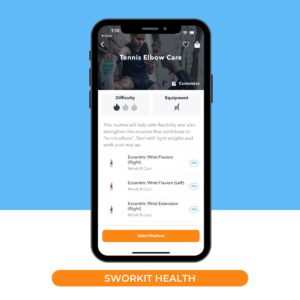“Tennis elbow” is more accurately called lateral epicondylitis. It does not just affect tennis players, despite the name (although it certainly can). You are at risk of tennis elbow if you engage in any repetitive motion of the wrist and arm. Plumbers, painters, carpenters, and butchers often experience it.
Symptoms of Tennis Elbow
Tennis elbow is caused by the tendons in your elbow becoming overloaded. Symptoms include:
- Pain that radiates from the outside of your elbow into your forearm and wrist.
- Difficulty shaking hands, gripping an object, turning a doorknob, or holding a coffee cup.
The condition can also cause weakness in the hand and forearm. It can be extremely painful and can interfere with your daily life. A doctor will make a diagnosis based on a physical exam by applying pressure or asking you to move your elbow, wrist, and fingers. You may, however, receive x-rays to eliminate other possible causes.
Treatment: Self-care and Professional
In most cases, tennis elbow gets better with basic self-care. This means rest, ice, and over-the-counter pain relievers. If this does not work, your doctor may prescribe physical therapy to teach you exercises that can help. You can also do exercises at home that can help with treatment and prevention.
Severe cases of tennis elbow might require joint injections, ultrasound treatment, or even surgery. However, this is rare.
If your condition is caused by playing tennis, your doctor may recommend that you work with a coach to improve your form and reduce your risk of developing it again.
Again, in most cases, rest and simple self-care will resolve the symptoms. However, as long as you engage in repetitive activity, symptoms may return. Basic exercises can help keep it at bay.
Effective Exercises for Tennis Elbow
Here are some particularly good exercises to help you recover from and prevent tennis elbow. Consider these exercises if you are at risk of tennis elbow, whether from your occupation or athletic activities. You can do them with both hands or only your affected one.
- Wrist Flexion. Take a very light weight and sit down. Support your affected forearm with your wrist hanging and the weight in your hand. Raise your wrist. If having difficulty, consider using a water bottle or soup can instead of a weight.
- Two Hand Wrist Extension. While standing, lift your affected arm in front of you at shoulder height, fingers pulled back and pointed at the ceiling. Use your other hand to gently pull your fingers back and stretch your wrist. Hold.
- Grip Squeeze. Take a towel and roll it up. Sit down. Hold the towel roll in your affected hand, squeeze as tight as you can, and hold.
- Thumb Opposition. Sit down. Use your thumb to tap the ends of your fingers from your index to middle, to ring, to pinky, and back.
- Biceps Curl. Stand with feet shoulder width apart, back straight, and head up. Lower your arms to the side of your body, palms facing forward. Curl your arms up from the elbow so your fists curl up towards your shoulders, palms facing you, then lower.
Sworkit also has a tennis elbow workout that covers both arms and includes wrist flexion and extension, as well as thumb opposition and wrist curls. If you are working with a physical therapist, talk to them about which exercises are best at your stage of recovery. Again, these exercises and stretches can also help keep you from developing tennis elbow if done regularly.
Tennis elbow is not just for tennis players and can be painful. However, effective exercises and stretches can help prevent tennis elbow if your hobbies or occupation put you at higher risk.


Comment section